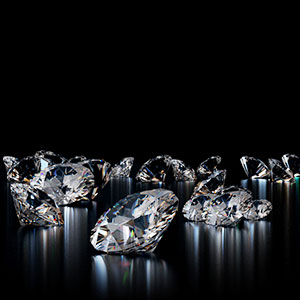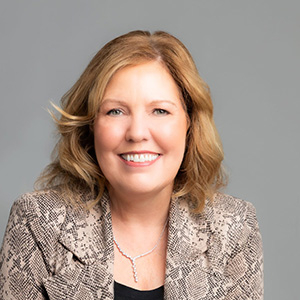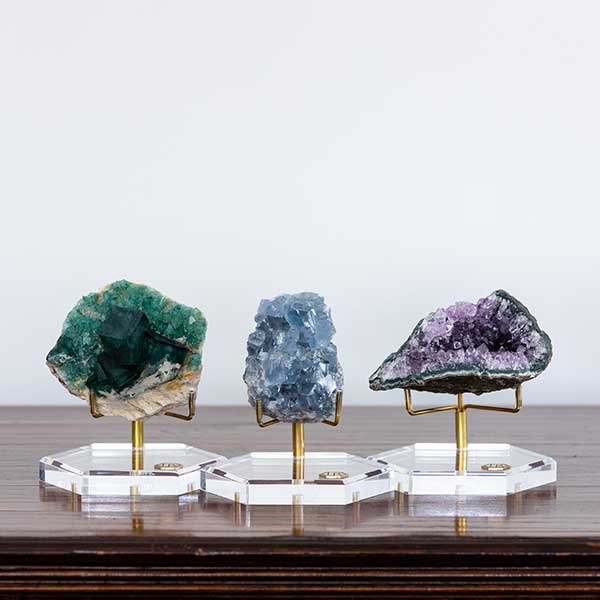
Denver-based jewelry industry friends Nan Lung Palmer and Kelle Phoundoulakis had just returned from the Tucson gem shows in 2020, when the pandemic upended their respective business plans.
Palmer is a merchandising, product development, and inventory management expert who’d worked at Macy’s and David Yurman before founding her own jewelry consulting firm, Facets. And Phoundoulakis is a real estate agent-turned-designer who, together with her husband Manos Phoundoulakis (now the director of business development for the high-end gem dealer Gems of Note), founded an edgy line of jewelry called Gold and Smoke. But during the pandemic, the women found themselves at loose ends.
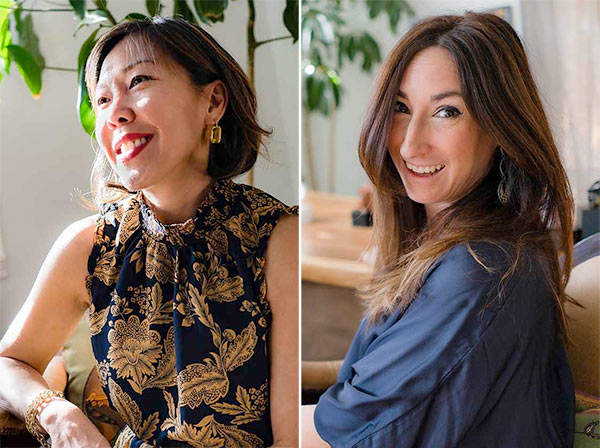
“While I was at home losing my mind, I was looking at these beautiful minerals I’d gotten in Tucson before the shutdown,” Palmer, a mother of three, recalls. “Is there something else I could do to keep my mind fresh?”
She went to the Phoundoulakis home for dinner last August and voiced the idea to the couple. “Coming from Tucson, I kept thinking, a mineral or crystal specimen is artwork made by Mother Nature, but no one has ever elevated it, made it sexy,” says Palmer. “What about having a subscription, where you get a different crystal every month, and it comes beautifully packaged on a little stand? Wouldn’t that be a great way to gift somebody?”
The result of that conversation, LuxeRox, is a new woman-owned brand of museum-caliber crystal specimens. Available to consumers on a buy-now or subscription basis (the company offers three-, six-, or 12-month plans that cost $125, $110 and $95 per month, respectively), the specimen boxes are also available to retailers as corporate gifts, tokens of client appreciation, or branding or display elements. Cofounded by Palmer and Phoundoulakis in March of this year, the brand exhibited for the first time at last month’s HardRock Summit in Denver.
“We’re coming off a bit of a high from doing the show,” says Phoundoulakis. “What was so interesting for us is that everyone in that room was a potential client: the retailers, the jewelers, the consumers.”
Below, Palmer and Phoundoulakis talk to JCK about how minerals can enliven a retail display, why the colored stone and crystal worlds remain so disconnected, and how they’re targeting Gen Z.
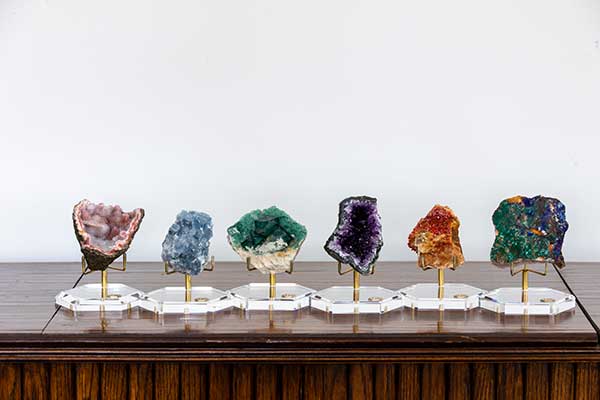
How would you describe your wholesale offering?
Nan Lung Palmer: Our original business plan was to go direct to consumer, with the idea that LuxeRox would be a stepping stone—pun intended—for people who wanted to start a mineral collection. On one side, there are the kinds of minerals you saw at the Evolution show at HardRock—stuff that very few people can afford. Or you go in the other direction, to stuff on Etsy. There was never anything in between.
Our idea was to create a much more niche market in the mineral world, a step away from the grungy specimens you find at Tucson or Quartzsite. The plan was to go into wholesale, but we thought it might not go in that direction for a couple years. But we’re pivoting now and utilizing the wholesale aspect to get additional brand recognition.
Kelle Phoundoulakis: The whole concept is that we’re bridging the gap between crystals and finished jewelry. Think of us as the gateway to genuine mineral collecting. We’re all about attainable luxury to decorate your home.
Why do you think more retailers should consider working with mineral specimens?
Palmer: From a retail perspective, the finished gems and rough minerals go hand in hand; they tell a story. We have some retailers buying them for displays, others buying more for client gifting.
Phoundoulakis: Because of our relationships with retailers, we had someone reach out from Florida. She’s doing a trunk show and wanted 100 beautiful geodes to impress her clients. Each customer of hers will receive a LuxeRox specimen with the invitation. Who would turn down an invite like that? That put a light bulb in our heads: customer appreciation! Retailers can send LuxeRox as a gift or use it as a marketing tool.
Palmer: Our best-selling minerals retail for $200, on average. The wholesale buy-in is $100 per piece. That includes the stand and a velvet pouch. Shipping is separate. The minimum purchase is $2,000. In comparison to the jewelry world, it’s really nothing. Essentially, we are trying to brand the mineral world. In the mineral world, can you think of one single brand you can go to for minerals and fossils?
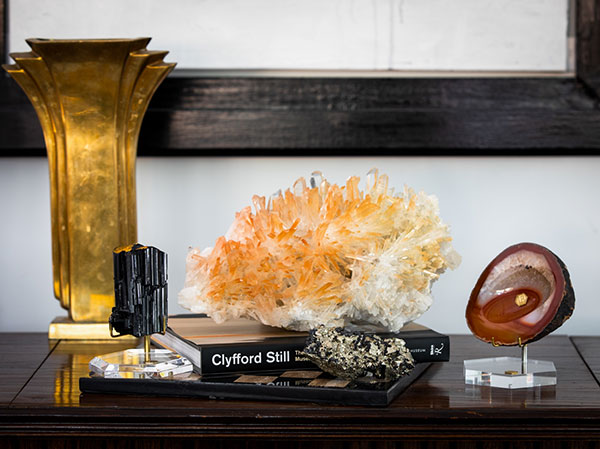
Why do you think this category remains virtually unbranded?
Palmer: I’m a novice—I just went to the Tucson gem shows for the first time a year and a half ago—but maybe that’s why I see it with a fresh pair of eyes. The mineral world is either unattainable or it’s grungy. There’s nothing in between. The prices are everywhere: Kelle and I have seen the same specimens we buy for a reasonable price, and we see them behind people’s cabinets, where the same exact specimen, same color and saturation, costs 10 times more.
Phoundoulakis: We recently saw a store in Breckenridge that sold something for $900 that we sell for $200. It could have had a tiny nick, but none of our customers would care about that.
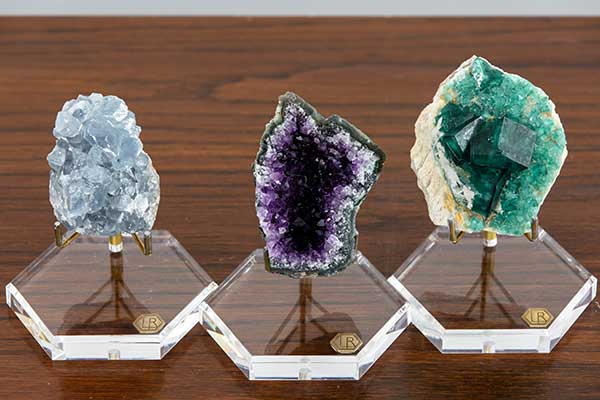
What’s the scale of your specimens, and how do you communicate that?
Palmer: When you’re looking at specimens online, you see something gorgeous and when you get it, it’s 3 cm high. We want people to understand that LuxeRox stands for palm-size specimens. We do have a variety of much larger specimens, but the idea is we’re all talking about Gen Z—much like in the jewelry world—and the next wave of customers, and how do you get them interested in minerals and specimens? You start them at a reasonable price, and once you get them hooked, they’ll go for larger specimens. We’re creating demand.
Phoundoulakis: Nan did a really good job of creating one-pagers that have all the key info on each specimen—“This is malachite, this is where it’s from, here are a few key points”—so the retailer can easily educate the customer.
The gem and mineral worlds have so much in common, yet remain so disconnected. What are some ways retailers can help bridge the gap?
Palmer: I’ve got a merchandising background, and I know a lot of jewelers overload their cases when in reality, less is more. Why not enhance your case with something beautiful? Let’s say you’re doing a blue story. Wouldn’t it be cool to pop an azurite mineral in there? People are drawn to colors and silhouettes. These minerals are so rich and colorful and saturated, they would only enhance your cases.
Phoundoulakis: Plus, there’s a story behind each one. It’s the easiest tool to get a conversation going with any customer.
Palmer: You’re also helping the end consumer understand the process it takes to get from a rough mineral to a faceted stone set in a finished jewel. A lot of times, you have to take a step back and understand that’s a long process. Someone has to find the stone, cut the stone, set the stone. Having crystal specimens on hand would only enhance that customer experience and help them understand why gems cost so much.
Top: A sampling of mineral specimens on LuxeRox branded display stands
Follow JCK on Instagram: @jckmagazineFollow JCK on Twitter: @jckmagazine
Follow JCK on Facebook: @jckmagazine

